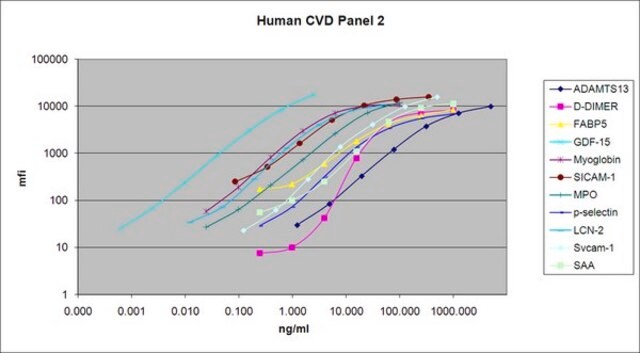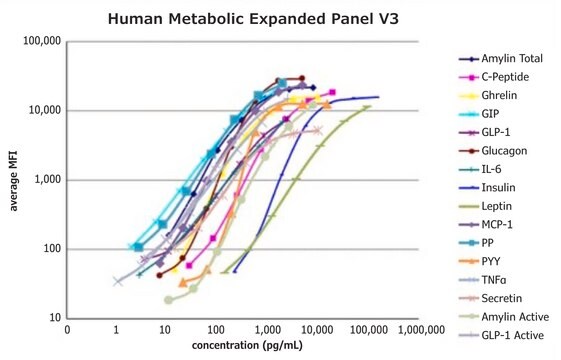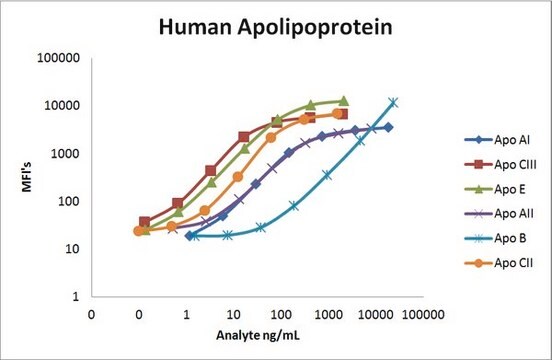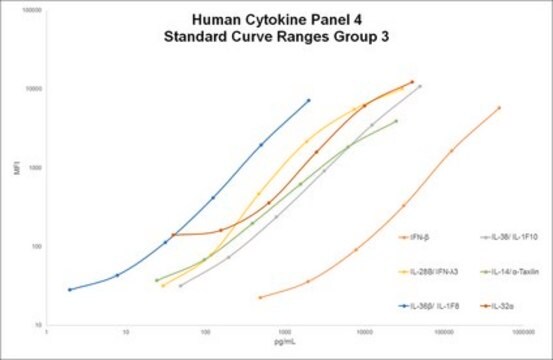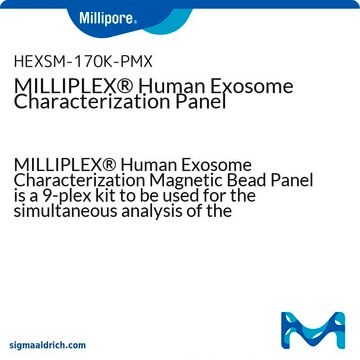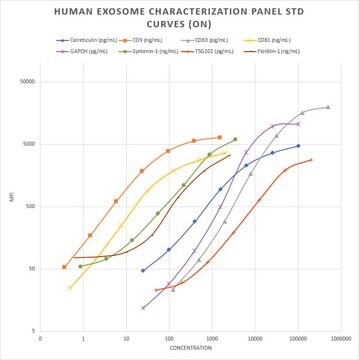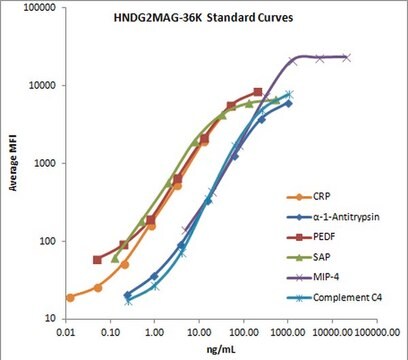HCVD3MAG-67K
MILLIPLEX® Human Cardiovascular Disease (Acute Phase) Magnetic Bead Panel 3 - Cardiovascular Disease Multiplex Assay
The analytes available for this multiplex kit are: Adipsin, AGP, α2-Macroglobulin, CRP, Fetuin A, Fibrinogen, L-Selectin, Serum Amyloid P, Haptoglobin, & Platelet Factor-4.
Sinónimos:
human CVD APP immunoassay panel, luminex human cardiovascular disease acute phase proteins multiplex assay, millipore human CVD acute phase proteins multiplex kit
About This Item
Productos recomendados
Nivel de calidad
reactividad de especies
human
fabricante / nombre comercial
Milliplex®
assay range
accuracy: 102%
(Haptoglobin)
accuracy: 109%
(AGP)
accuracy: 113%
(Platelet Factor-4)
accuracy: 117%
(Adipsin)
standard curve range: 0.004-15 ng/mL
(L-Selectin & SAP)
standard curve range: 0.012-50 ng/mL
(CRP)
standard curve range: 0.037-150 ng/mL
(PF4)
standard curve range: 0.061-250 ng/mL
(HPTGN)
standard curve range: 0.098-400 ng/mL
(AGP & Adipsin)
standard curve range: 0.244-1,000 ng/mL
(Fetuin A & vWF)
standard curve range: 0.488-2,000 ng/mL
(A2M)
técnicas
multiplexing: suitable
método de detección
fluorometric (Luminex xMAP)
Condiciones de envío
wet ice
Descripción general
MILLIPLEX® Human Cardiovascular Disease (CVD) Panel 3 (Acute Phase) is a 10-plex kit to be used for the simultaneous quantification of any or all of the following analytes in human serum, plasma or tissue/cell lysate and culture supernatant samples: Adipsin, α-1-Acid-Glycoprotein (AGP), α-2-Macroglobulin (A2M), C Reactive Protein (CRP), Fetuin A, Fibrinogen, L-Selectin, Serum Amyloid P (SAP), Haptoglobin, and Platelet Factor-4 (PF4). (Please note: Fibrinogen is not detectable in serum.) This kit uses a 96-well format, contains a lyophilized standard cocktail, two internal assay quality controls and can measure up to 38 samples in duplicate.
The Luminex® xMAP® platform uses a magnetic bead immunoassay format for ideal speed and sensitivity to quantitate multiple analytes simultaneously, dramatically improving productivity while conserving valuable sample volume.
Panel Type: Cardiovascular
Aplicación
- Analytes: α-1 Acid Glycoprotein (AGP), α-2-Macroglobulin (A2M), Adipsin (Factor D), C Reactive Protein (CRP), Fetuin A, Fibrinogen, Haptoglobin, sL-Selectin, Platelet Factor-4 (PF4/CXCL4), Serum Amyloid P (SAP)
- Recommended Sample Type: Human serum, plasma, cell/tissue culture supernatants and lysates
- Recommended Sample Dilution: 25 μL per well of 1:40,000 diluted serum or plasma; tissue/cell culture samples may require dilution in appropriate control medium
- NOTE: Fibrinogen is not detectable in serum
- Assay Run Time: Overnight (16-18 hours) at 2-8°C or 2 hours at room temperature (20-25 °C)
- Research Category: Cardiovascular Disease
- Research Subcategory: Metabolic Disorders
Características y beneficios
Otras notas
Información legal
Palabra de señalización
Danger
Frases de peligro
Clasificaciones de peligro
Acute Tox. 3 Dermal - Acute Tox. 4 Inhalation - Acute Tox. 4 Oral - Aquatic Chronic 2 - Eye Irrit. 2 - Skin Irrit. 2 - Skin Sens. 1 - STOT SE 3
Órganos de actuación
Respiratory system
Código de clase de almacenamiento
6.1C - Combustible acute toxic Cat.3 / toxic compounds or compounds which causing chronic effects
Certificados de análisis (COA)
Busque Certificados de análisis (COA) introduciendo el número de lote del producto. Los números de lote se encuentran en la etiqueta del producto después de las palabras «Lot» o «Batch»
¿Ya tiene este producto?
Encuentre la documentación para los productos que ha comprado recientemente en la Biblioteca de documentos.
Nuestro equipo de científicos tiene experiencia en todas las áreas de investigación: Ciencias de la vida, Ciencia de los materiales, Síntesis química, Cromatografía, Analítica y muchas otras.
Póngase en contacto con el Servicio técnico